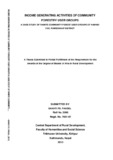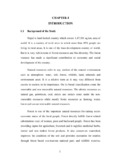Please use this identifier to cite or link to this item:
https://elibrary.tucl.edu.np/handle/123456789/2237| Title: | Income Generating Activities of Community Forestry User Groups A Case Study of Ramite Community Forest User Groups of Namadi Vdc, Ramechhap District |
| Authors: | Paudel, Shanti Pd. |
| Keywords: | Community;Socio economic;Forestry |
| Issue Date: | 2019 |
| Publisher: | Central Department of Rural Development |
| Abstract: | Community forestry is a small scale, village level forestry practice where decisions and actions are often made on a collective basis, and where the rural population participate in forest conservation planning, establishment, management and harvesting of forest crops and receive a small proportion of the socio-economic and ecological benefits from the forest. Community forestry was introduced in Nepal in 1978. The community forestry approach has been highly successful in the protection of the forest in the hills of Nepal. The local user groups are responsible for the control, protection, and management of the forest. This research is done on the current issue of income generation activities. Forest as local resources are main resources and also source of livelihood of flora, fauna and human beings. This study focuses on income generation of Ramite CFUGs of Ramechhap district. The main objective of this study is to investigate on Income Generating Activities. However, other specific objectives are; • To analyze the socio-economic status of the forest users group. • To asses the income generating activities of forest user groups. This study has adopted both the descriptive and exploratory research designs. Out of 310 households only 13 percent (40 HHs) had been selected by purposive sampling. On the process of data collection both primary and secondary sources has been used. The above study shows that the resources of CF had changed the socio-economic status of the local communities as well as the level of participation had been increased rapidly. But for the further work it is recommended to adopt better trainings, skills, awareness. The study was carried out in Namadi VDC of Ramechhap district. The methodology of the study included both the qualitative and quantitative method. Data was collected through in household questionnaire with 40 households different ethnic group sampled through sample random sampling method. The major findings of the study were, • The forest users comprise of 8 ethnic groups dominated Chhetri 37.5%, Sunuwar 17.5%, Gharti 7.5%, Kami 12.5%, Brahmin 2.5%. • Service and agriculture is the major economic activities for majority of forest users households. • Average family size of lower castes as Damai, Kami, Sarki have large number (5.4) and other castes have smaller family size comparatively and total average family size is 4.725 in sample HHs. • Educational status of sampled households literate 78.61 and illiterate only 21.39 but woman are illiterate in majority. • The main vision of this CFUGs to reduce poverty by improving live, livelihood, agriculture and income generating program through forestry. The forest conduction is found good on the CFUGs, plants are growing day by day and the greenery of forest gives an attractive scene from which people can take a kind of pl |
| URI: | http://elibrary.tucl.edu.np/handle/123456789/2237 |
| Appears in Collections: | Rural Development |
Files in This Item:
| File | Description | Size | Format | |
|---|---|---|---|---|
| Cover Page(5).pdf | 89.27 kB | Adobe PDF |  View/Open | |
| Chapter(1).pdf | 630.17 kB | Adobe PDF |  View/Open |
Items in DSpace are protected by copyright, with all rights reserved, unless otherwise indicated.
